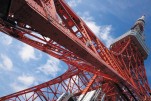Old Symbol of New Japan

In the late 1950s Japan was recovering from the horrors of World War II and the country’s economy raised at a rapid rate. That was a time when the nation needed a powerful rebirth symbol, which would be understandable not only to the Japanese, but to the whole world. In addition, in the context of the communication boom, a compelling need for building in the country a powerful transmission tower appeared. It was the new television tower that was destined to become the main symbol of the “economic miracle” of Japan, representing a renewed and ambitious country.
A distinctive feature of the history of Japanese culture is a selective, active interest in the best international practices. For many centuries, the Japanese have mastered the innovations that they assessed as relevant and promising. One of the main platforms for observing international best practices for the Japanese was primarily the World Exhibitions, which importance the Japanese rated very highly. At the World Exhibition in 1889, which was held in Paris, the Japanese delegation examined with great interest the Eiffel Tower - a grandiose structure, completely made of metal. The huge influence of the architectural and artistic image of this world’s tallest tower is easy to trace in the appearance of the very first television tower of Japan.
Tokyo Tower — a communications and observation tower (architect T. Naito, Nikken Sekkei) was built 333 meters high in 1958. Certainly, the French symbol served as its prototype, and one could easily notice that in the appearance of its tetrahedral configuration, the Tokyo Tower very much resemble the creature of Eiffel.
Back in 1953, the Japanese state-owned television and radio company Nippon Hōsō Kyōkai (NHK) began broadcasting in the Tokyo area of Kanto, building its own broadcast tower. Television quickly conquered the world, several companies broadcasting in the city and its environs began to work in Tokyo. As the number of companies increased, and each of them set up its own transmission tower, the city authorities realized that this way the television companies would build up the area with their antennas to increase the coverage area and attract new viewers. The spontaneous construction of television towers could damage the originality of the city, depriving it of its historical identity. Under the influence of the authorities, television companies agreed to build one edifice instead of several towers, the capabilities of which would be enough for everyone.
Full content of this issue you can read here
The full version of the article can be read in our printed issue, also you can subscribe to the web-version of the magazine
 Text by Nina Konovalova
Text by Nina Konovalova


